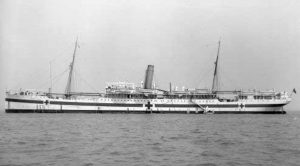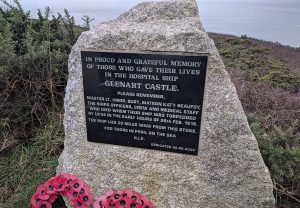 Hospitals and hospital ships should be off limits during a war…even to the enemy. Some things should be considered sacred n the work hospitals do, should not be attacked. Unfortunately, that doesn’t always seem to matter. The Glenart Castle was a hospital ship during World War I. On March 1, 1917, the ship suffered damaged when she struck a mine in the English Channel 8 nautical miles northwest of the Owers Lightship on 1 March 1917. The ship was repaired and returned to service. That damage was accidental. What happened later was not.
Hospitals and hospital ships should be off limits during a war…even to the enemy. Some things should be considered sacred n the work hospitals do, should not be attacked. Unfortunately, that doesn’t always seem to matter. The Glenart Castle was a hospital ship during World War I. On March 1, 1917, the ship suffered damaged when she struck a mine in the English Channel 8 nautical miles northwest of the Owers Lightship on 1 March 1917. The ship was repaired and returned to service. That damage was accidental. What happened later was not.
On February 26, 1918, Glenart Castle was leaving Newport, South Wales, on its way to Brest, France. Fishermen in the Bristol Channel saw her clearly lit up as a hospital ship. That was supposed to let everyone know that they were not to fire on the ship. John Hill, a fisherman on Swansea Castle, remembered “I saw the Hospital Ship with green lights all around her – around the saloon. She had her red side lights showing and mast-head light, and also another red light which I suppose was the Red Cross light.” Nevertheless, being lit up did nothing for the Glenart Castle. At 04:00, Glenart Castle was hit by a torpedo in the number 3 hold. The blast destroyed most of the lifeboats, and the subsequent pitch of the vessel as I listed hindered attempts to launch the remaining boats. In the eight minutes the ship took to sink, only seven lifeboats were launched. Rough seas and inexperienced rowers swamped most of the boats.
Of the 194 people o board, only 32 survived. A total of 162 people were killed, including the Captain, Bernard Burt, eight nurses of the Queen Alexandra’s Imperial Military Nursing Service, seven Royal Army Medical Corps (RAMC) medical officers and 47 medical orderlies. Of the hospital patients being treated on board, a total of 99 died. The matron of Glenart Castle, Miss Kate Beaufoy (1868-1918), was among those killed in the sinking. Beaufoy was a veteran of the South African War and the Gallipoli campaign. She kept a diary of her time on the ship. It is all her family has now. Evidence was found suggesting that the submarine that fired the torpedo may have shot at initial survivors of the sinking in an effort to cover up the sinking of Glenart Castle. It wasn’t bad enough that the hospital ship had been sunk, but they tried to make sure there were no survivors too. The body of a junior officer of Glenart Castle was recovered from the water close to the position of the sinking. It was marked with two gunshot wounds, one in the neck and the other in the thigh. The body also had a life vest indicating he was shot while in the water.
After the war, the British Admiralty sought the captains of U-Boats who sank hospital ships, in order to charge them with war crimes. Kapitänleutnant Wilhelm Kiesewetter, the commander of UC-56, was arrested after the  war on his voyage back to Germany and interned in the Tower of London. He was released on the grounds that Britain had no right to hold a detainee during the Armistice. To my knowledge, he never paid for his crimes. A memorial plaque was dedicated on the 84th anniversary of the sinking, February 26, 2002 near Hartland Point. The plaque’s inscription read, “In proud and grateful memory of those who gave their lives in the hospital ship Glenart Castle. Please remember, Master Lieutenant Commander Burt, Matron Katy Beaufoy, the ships officers, crew and medical staff who died when their ship was torpedoed by UC-56 in the early hours of 26th Feb 1918. The ship lies 20 miles WNW from this stone. For those in peril on the sea. R.I.P. Dedicated 26.02.2002.”
war on his voyage back to Germany and interned in the Tower of London. He was released on the grounds that Britain had no right to hold a detainee during the Armistice. To my knowledge, he never paid for his crimes. A memorial plaque was dedicated on the 84th anniversary of the sinking, February 26, 2002 near Hartland Point. The plaque’s inscription read, “In proud and grateful memory of those who gave their lives in the hospital ship Glenart Castle. Please remember, Master Lieutenant Commander Burt, Matron Katy Beaufoy, the ships officers, crew and medical staff who died when their ship was torpedoed by UC-56 in the early hours of 26th Feb 1918. The ship lies 20 miles WNW from this stone. For those in peril on the sea. R.I.P. Dedicated 26.02.2002.”


2 Responses to The Glenart Castle Sinking